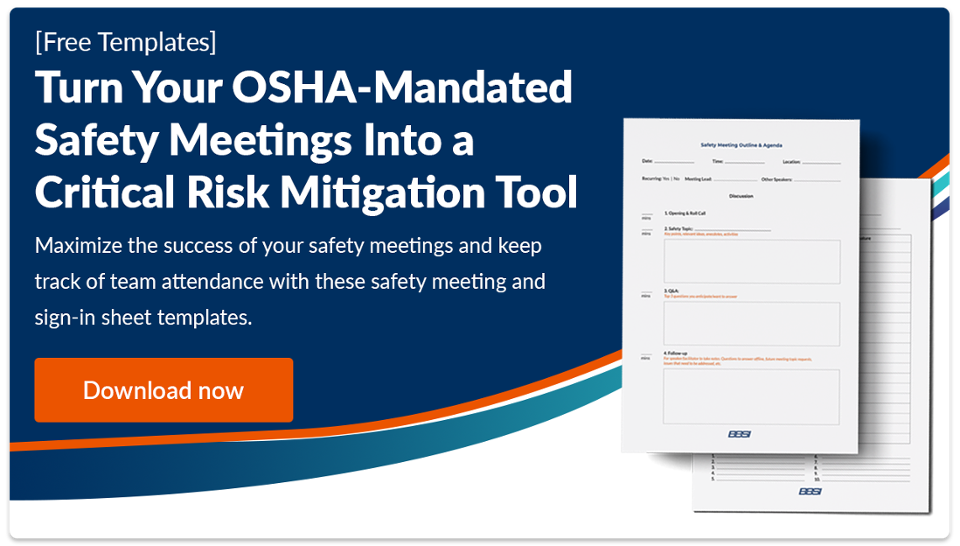
Making Job Sites Safer With Behavioral Safety Awareness
Expertise provided by Tucker Smith, BBSI Carolinas Area Manager, and Jack Nix, VP of Operations for Shelby Erectors
Some aspects of workplace safety may seem intuitive. For instance, having a basic awareness of your surroundings can go a long way in preventing accidents and maintaining a safe work environment. But in reality, anyone can get distracted, cut corners, or skip safety precautions without fully understanding the consequences. Over 2.6 million workplace injuries occurred in 2021, making it clear that behavioral safety is a major issue that can affect any workplace.
Creating a workplace culture that consistently values safety involves turning common sense into well-established, well-documented best practices. By instituting systems supporting employee safety, business owners can encourage everyone on their team to invest in their well-being and consistently make safer choices.
Create a team that is genuinely invested in workplace safety by reviewing this comprehensive guide and its complementary podcast. We explain how you can start your journey to a safer workplace, how to engage employees at all levels of your organization, and tips for maintaining a long-term safety culture.
Listen to the BBSI Entrepre(doers) Podcast
In this episode, Tucker Smith, BBSI Carolinas Area Manager, and Jack Nix, VP of Operations for Shelby Erectors, join the show to talk about the importance of job site safety. While many think safety boils down to common sense, it requires buy-in from everyone on the job site to get your team home safely each day. Learn what the costs are of delaying your setup of a safety program in our latest episode below.
How to Create a Culture of Safety
When team members collectively prioritize behavioral safety awareness, they create a culture that respects and upholds safety as a core value. Changing your company culture doesn't just involve asking employees to be more aware of their surroundings; it requires top-down policy changes with actionable steps workers can use to personally promote workplace safety. While procedural changes involve an up-front investment of time and energy, successful implementation can create lasting improvements that make your workplace safer for everyone.
1. Write a Safety Manual
A comprehensive safety manual gives employees a definitive reference to guide their decisions. Manuals should offer an overall rationale for how the company approaches occupational health and safety, plus practical steps for avoiding and responding to hazards.
Topics to reference in the manual may include:
- Routine safety checklists
- Hazard identification
- Safety audit procedures
- Emergency response plans
- Incident reporting processes
- Contact information for safety officers
After finalizing the safety manual, communicate these new standards to all relevant stakeholders, including employees, contractors, and vendors. Discuss the goals of your organization's safety policy and create a plan for achieving them through policy implementation.
Read: Why You Should Create an Employee Handbook and How to Get Started
2. Empower Employees
Your safety manual provides the framework for how employees promote organizational safety, but creating a culture change involves empowering them to incorporate these ideas into their day-to-day choices. Instead of simply directing employees on what they should be doing, engage them in conversation about how safety practices impact their duties. Seek feedback from your team members about their safety concerns, and focus on providing the information and tools they need to keep themselves and others safe.
3. Provide Consistent Oversight
To show behavioral safety is a priority, create oversight systems to maintain accountability for managers and their team members. Identify individuals to oversee safety efforts and act as a liaison for employees to ask questions or communicate workplace safety concerns. Develop a system for auditing behavioral safety and for providing feedback and training when any issues arise.
4. Communicate Openly and Clearly
Establish an open line of communication about safety issues by hosting regular safety meetings. Depending on the risk level of your workplace, you may schedule these check-ins on a monthly, weekly, or even daily basis. Regular safety meetings and discussions keep behavioral safety top-of-mind for all employees, ensuring no one becomes complacent or skips important safety steps. These meetings also provide opportunities for tenured employees to share insights with new hires, creating consistent best practices that all employees understand and implement.
Don't know where to start? Safety Meeting Best Practices & Topics to Cover ASAP

Responding to Injuries
Injuries and accidents can occur even in organizations with a healthy culture of behavioral safety awareness. Everyone in the organization must understand how to properly address the situation when injuries happen. Even for minor injuries, proper documentation and follow-up can help you identify gaps in your safety plan.
Safety Incident Reports
While safety reporting should be a key aspect of safety culture for employers – it's also a legal requirement. Ensure every employee understands what to do if a workplace injury occurs and that incident reporting processes are simple and accessible. By prioritizing accurate, thorough documentation, you show employees you take their well-being seriously and stand behind your safety policy.
Completing and filing incident reports provides management with valuable information about what types of injuries occur in the workplace and what circumstances led to those injuries. You can use these reports as benchmarks for assessing the success of your safety policies and training.
Identifying Root Causes
Root cause analysis is a thorough inspection of every factor that contributed to an injury or illness. OSHA requires certain employers to complete basic investigations of workplace incidents, but they encourage all employers to incorporate root cause analysis into their incident response procedures. When analyzing the root cause of an injury, it's important to focus on the facts of the situation instead of assigning blame. Helping employees grow and change their behavior in future situations allows managers to update any unsafe procedures.
Conducting a root cause analysis involves asking questions about the circumstances of an incident. For example, if an employee fell from a ladder, the root cause analysis of the situation may address the following questions:
- What task was the employee completing at the time of the fall?
- Was the ladder stable and properly maintained?
- Was the ladder appropriate for the job?
- Why weren’t harnesses, belts, or other personal fall arrest systems used?
- Did anything jostle or move the ladder?
- Were the surrounding conditions unsafe?
By considering all contributing factors, you can highlight potential gaps in your safety procedures. Sharing the results of a root cause analysis can also make employees aware of potential hazards they may not have noticed.
Breaking Down the DOIT System
Even the most extensive manuals cannot provide safety instructions for every potential scenario in the workplace. The DOIT system is a practical guide for managers and employees to make safer decisions, regardless of the situation.
This system uses four steps to improve workplace safety continuously:
Define
Employees observe their surroundings and list potential hazards, including environmental factors or behaviors, to define risks. Increasing awareness of workplace risks allows you to categorize them based on when they occur or who might encounter them.
Observe
Paying attention to unsafe behaviors and environmental factors allows you to gather information about why they occur. You can then set goals for mitigating risks and changing hazardous processes. When you observe risky behavior, coach your employees about safer ways to approach their work. By viewing workplace hazards as a learning opportunity, you allow everyone to be accountable for their safety.
Intervene
Intervention involves making major changes to prevent unsafe behavior. If employees continue to perform hazardous actions, appropriate intervention can include official training, targeted safety meetings, or the institution of new policies. When intervening, it's important to highlight current patterns of behavior and set clear expectations for behavioral safety in the future.
Test
Testing measures the impact of your intervention. After giving your team time to apply the requested changes, observe their behavior again to determine if it improves workplace safety.
Reinforcing Safety Practices
Creating a truly safe environment involves following up on safety practices. It's up to each team to determine the ideal frequency of safety audits and meetings for their workplace. Whether hosting an audit every week or every few months, you should have a regular schedule.
By frequently reinforcing safety principles, you encourage everyone on your team to develop positive habits and incorporate behavioral safety into their work. Audits hold everyone accountable for their impact on workplace safety, reminding each individual they play an important role in keeping themselves and others safe.
Tips for Promoting Behavioral Safety
Once you establish a culture that embraces safety principles, it's time to integrate and promote them. Consider these tips to do just that:
- Make safety a top priority: Think about how each of your business choices affects the safety of your team. By prioritizing safety above all other factors, you promote a positive relationship with your workforce and help manage organizational risks.
- Utilize your EMR: Your Experience Modification Rating (EMR) is a ratio insurance providers use to determine the cost of your workers' compensation premium. It assesses different factors, including frequency of claims, to assess future risk. Assessing your EMR can help you improve your safety systems, decrease risk, and better manage insurance costs.
- Budget for safety: Workplace safety is no time to cut corners. View your safety plan as an essential business cost and prioritize your safety plan when building your budget.
Remember, adjusting company culture takes time. But by committing to safety across multiple disciplines, you can shape the work environment you're striving for.
Wonder what to do after a workplace injury occurs? Modified Duty: Getting Employees Back to Work After an Injury
Support Organizational Safety with BBSI
Behavioral safety awareness throughout an organization helps its members avoid accidents and create reliable, long-term safety systems. BBSI provides comprehensive risk and safety solutions that target your organization's core causes of safety issues. By partnering with BBSI to educate and train your workforce, you empower your team to create and uphold a culture that values workplace safety.
BBSI's Risk & Safety Consultants use their expertise to identify your workplace's unique safety needs and create a plan to address hazards. By educating company leaders about practical safety fundamentals, BBSI helps businesses take control of their safety training and instill positive values throughout their teams.
Contact your local BBSI branch to discover how our safety services can instill behavioral safety into your company culture.
Disclaimer: The contents of this white-paper/blog have been prepared for educational and information purposes only. Reference to any specific product, service, or company does not constitute or imply its endorsement, recommendation, or favoring by BBSI. This white-paper/blog may include links to external websites which are owned and operated by third parties with no affiliation to BBSI. BBSI does not endorse the content or operators of any linked websites, and does not guarantee the accuracy of information on external websites, nor is it responsible for reliance on such information. The content of this white-paper/blog does not provide legal advice or legal opinions on any specific matters. Transmission of this information is not intended to create, and receipt does not constitute, a lawyer-client relationship between BBSI, the author(s), or the publishers and you. You should not act or refrain from acting on any legal matter based on the content without seeking professional counsel.


